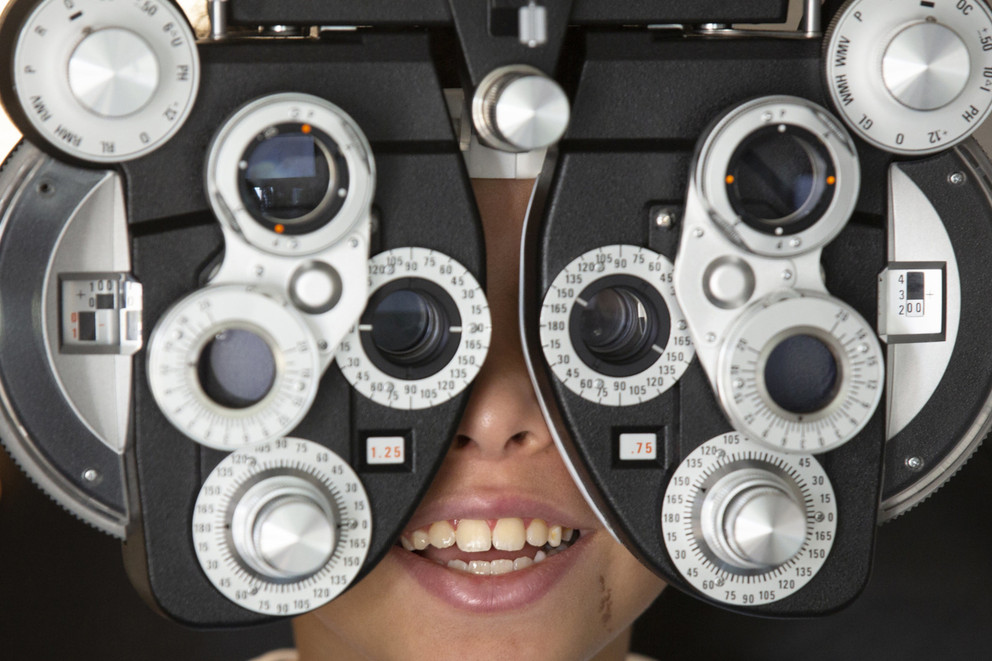
The back-to-school season provides a good reminder for parents to focus on their children’s eye health. While pediatricians routinely screen infants and toddlers for vision problems, parents should also be aware of common eye conditions. With knowledge and action, they can help set up their children for healthy vision — for the classroom and beyond.
-
Early check-ups and possible concerns
Every well-child visit from newborn on up should have a vision component, according to Dr. Amanda Ely, an ophthalmologist at Penn State Health Eye Center. “The pediatrician is looking for a symmetric red reflex. If it’s asymmetric, dull or white, the child may have a refractive error requiring glasses, strabismus (eye crossing or drifting), cataracts or even a disease of the retina.” For proper diagnosis and treatment, the child should be referred to a pediatric eye specialist.
Many infants and young children may have mild refractive errors that don’t need to be corrected right away. “However, a large degree of farsightedness, nearsightedness or astigmatism may adversely affect a child’s vision development,” Ely said. If it is blurring their vision too much or leading to strabismus — a misalignment of the eyes — they’ll need corrective glasses.
Another common concern is amblyopia, which can happen when a child has one eye with better visual potential than the other, according to Ely. The brain may favor the stronger eye and only concentrate on it for vision development, ignoring the other eye.
“The earlier you can intervene, the better able you are to correct the amblyopia and prevent permanent vision loss in the weaker eye,” Ely said. She advises that parents with a known family history of amblyopia take their child to a pediatric eye specialist for a screening. “A specialist can catch the subtle signs of an eye disorder that a parent may not notice till much later,” she said.
-
Vision problems in the virtual classroom
Although most children outgrow their farsightedness by the time they reach elementary school, they may start to develop nearsightedness — difficulty seeing things in the distance. Cultural trends — such as more time indoors and focusing on near activities — and online schooling during the COVID-19 pandemic may put kids more at risk for this vision problem.
“On average kids spend seven hours a day on a device,” Ely explained. “This causes eye strain and dry eyes — you blink less when you’re staring at a screen — which leads to complaints of blurry vision and/or headaches.”
Neither the American Academy of Ophthalmology nor the American Academy of Optometry endorse blue light-blocking glasses for children during screen time, according to Dr. Ajay Soni, an ophthalmologist at Penn State Health Eye Center. But they do recommend the 20-20-20 rule. “Exercise your eyes by looking at an object at least 20 feet away every 20 minutes for at least 20 seconds,” Soni said.
“It’s different in the physical classroom,” he continued. “When you’re looking at something across the room, your eyes are more relaxed. When you’re focusing on something up close like a computer screen, your eyes have to accommodate. That can cause fatigue and headaches.”
-
When to call the doctor
Frequent afternoon headaches are a cause for concern. “It could simply be a sign that the child needs to take those breaks every 20 minutes,” Ely said. “Or maybe they’re focusing too hard because they can’t see well, which may indicate they need glasses.”
A child who squints often could be having trouble seeing at a distance and should have their vision tested, Ely said. “And, particularly a young child who blinks or winks frequently with just one eye could be experiencing double vision caused by strabismus and should be evaluated by a pediatric eye specialist.”
There is one eye condition that is much more common among those attending daycare or in-person school: conjunctivitis. Symptoms include a tearing, pink eye that may look a little swollen. The infection usually is viral and goes away without treatment, Soni said, noting that there is one important red flag: pain.
“Pink eye is usually not painful. If the child is constantly trying to keep the eye closed, it could indicate pain,” Soni said. Pain could be a symptom of a corneal infection or possibly uveitis, an inflammation on the inside of the eye. “That’s typically an autoimmune condition but it could also be an infection.” Soni advises seeking medical guidance anytime that there’s pain associated with pink eye.
For the common viral infection, kids may have an advantage with the heightened attention to hand hygiene in schools this fall.
“Pink eye is spread by contact,” Soni said. “If the child rubs their eye and then touches something, then someone else touches that object and then their eye, they can catch it.”
Original source: https://news.psu.edu/story/627719/2020/08/06/medical-minute-common-eye-conditions-children?utm_source=newswire&utm_medium=email&utm_term=627788_HTML&utm_content=08-06-2020-21-55&utm_campaign=Penn%20State%20Today